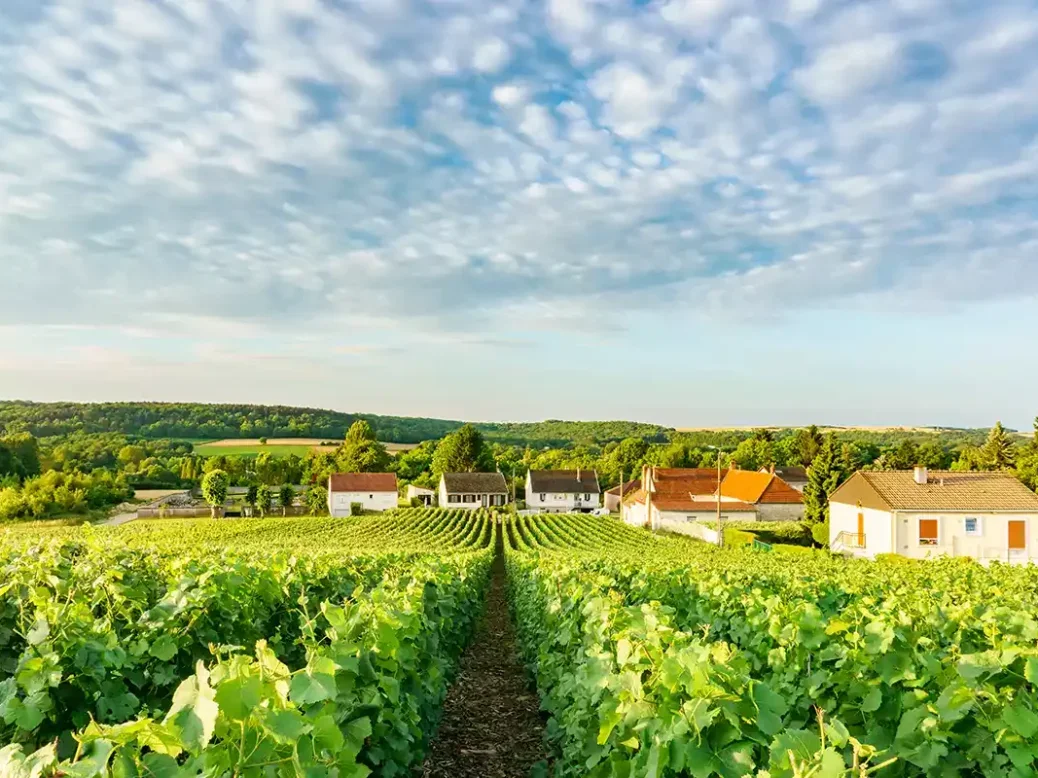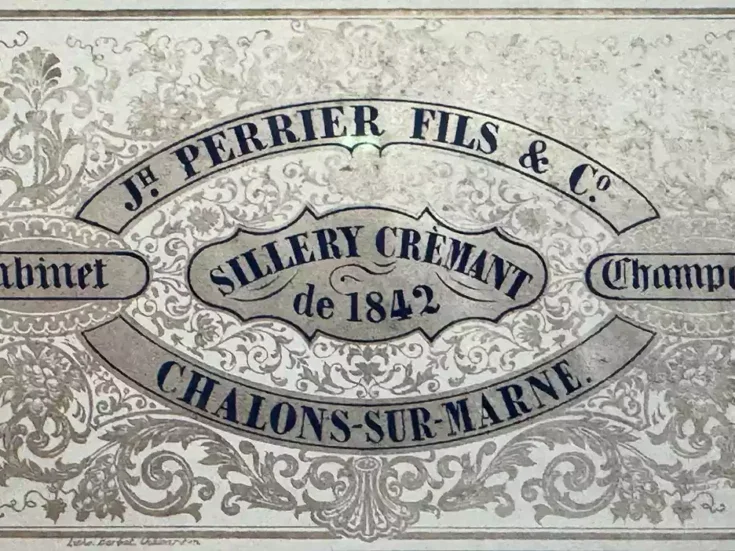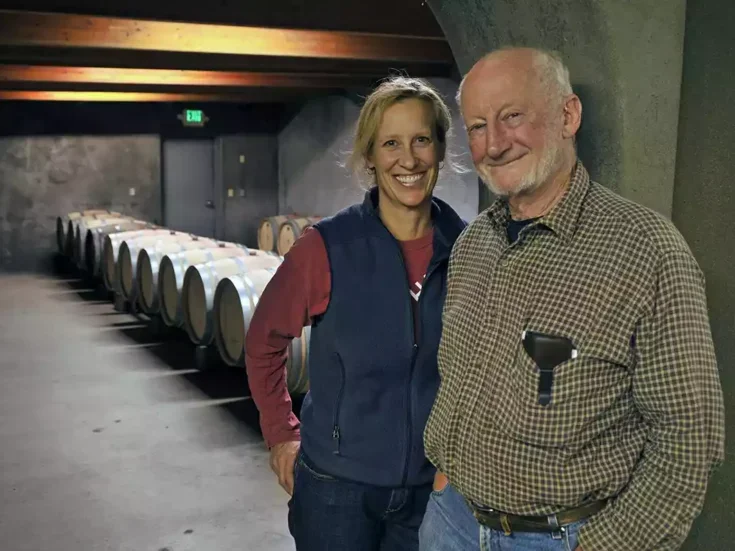
Essi Avellan MW introduces a tasting of Montagne de Reims Chardonnay shared with fellow revelers Simon Field MW and Anthony Rose, that shed new light on the distinctive blanc de blancs from the north of the region and revealed them as coming in darker but equally exhilarating shades of pale.
The tightly knit and elegant blanc de blancs of the Côte des Blancs are world-famous, yet Champagne has so much more to offer on the Chardonnay front. There are some less renowned subregions focusing strongly on the grape, namely Vitryat (98%), Montgueux (90%), and the Sézannais (75%). The Montagne de Reims is recognized for its monumental Pinot Noirs, and a mere 26% of the vineyard land is dedicated to Chardonnay, yet its primarily chalky soils show great potential for Chardonnay as well. “Ils pinotent,” the locals say of the richer, fruit-forward style of Chardonnays that they think borrow some features from Pinot Noir.
Previously, it was hard to put one’s finger on what exactly was Montagne de Reims blanc de blancs, as the wines were normally blended into multiregional cuvées. Today, however, thanks to the ever-strengthening trend of site-specific Champagnes, we were able to put the region’s Chardonnays to the test.
The Montagne de Reims is situated around the city of Reims, most notably to the south and west of it. It can be divided further into four subregions: Grande Montagne de Reims, Vesle and Ardre, Massif de St-Thierry, and Monts de Berru. Its most celebrated part is the Grande Montagne, with vineyards planted on the forest-capped hill’s northern, eastern, and southern sides. This is where all the Montagne de Reims’s nine grand cru villages are situated. Chalky soils predominate, and aspect makes all the difference to the style. The south-facing amphitheater shape of Bouzy (13% Chardonnay), for example, lends its wines an unparalleled richness, whereas the more southeast-facing Ambonnay (19%) gives the wines a further finesse on top of all the fruity power. On the northern side, a certain cool linearity drives the wines of grands crus Verzy, Verzenay, and Mailly-Champagne. Amid the Pinot Noir terroirs, the subregion’s east-facing premier cru villages of Villers-Marmery (98%) and Trépail (93%) focus on Chardonnay, thanks to their favorable aspect and chalk-rich terroirs.
The broad Vesle and Ardre Valleys’ area also includes the so-called Petite Montagne, where we find premier cru villages like Écueil and Sacy. Here the soils are a variable mix of sand, clay, and limestone. Chardonnay represents a mere 14%, with a strong dominance of Meunier plantations. The Massif de St-Thierry on the northwest side of Reims is of great historical importance, yet today its vineyards on largely sandy terroirs have shrunk to 1,000ha (2,500 acres), of which 18% are planted to Chardonnay. Lastly, the Monts de Berru vineyards hug the Mont de Berru to the west of Reims, with notable dominance of Chardonnay (92%), thanks to the high chalky presence in the soil.
An appreciative consensus
We limited our tasting to the Union des Maisons de Champagne classification of Montagne de Reims presented above, thus excluding the Grande Vallée villages such as Mareuil-sur-Aÿ, which many do see as part of the Montagne. Most of the Champagnes came from grower domaines for the simple reason that very little Montagne de Reims-specific blanc de blancs is produced by the houses. Leclerc Briant was the sole representative of the houses, with a single-vineyard cuvée from its Villers-Allerand clos. Indeed, a lion’s share of the wines came from single sites, with 12 different plots represented. In addition, we had single-village cuvées from Jean Vesselle, François Secondé, and A Margaine, and a dual-village cuvée from Penet-Chardonnet. No “broad” Montagne de Reims blends were included.
We were all pleased with—even positively surprised by—the quality of the wines, reflected in the very high average score of 92. Of all the Champagne tastings I have done for The World of Fine Wine, this was certainly the one that achieved the strongest consensus. The invited producers were carefully selected, which may explain some of the success rate. Moreover, Chardonnays tend to be much less prone to oxidation than wines from Champagne’s red varieties—a character that would for sure have divided opinion. Chardonnay is known to love oak, and many of the cuvées here had benefited from the skillful use of barrels for additional complexity.
The tasting ended up being a celebration of terroir Champagnes. To nobody’s surprise, the grand cru terroirs fared brilliantly, with Ambonnay (Marguet Le Parc) and Bouzy (Pierre Paillard Les Mottelettes) cuvées making it into the top four. But it was not all about grands crus, as Hugues Godmé Les Alouettes St Bets from premier cru Villers-Marmery, and Chartogne-Taillet Chemin de Reims from the Autre Cru of Merfy, did equally well. The top four wines all came from two great Champagne vintages: the intense yet refined 2019 and the fruit-forward and generous 2012. It was fascinating to taste a few more mature Champagnes in the lineup. Both Pierre Paillard Les Mottelettes 2012 and Hugues Godmé Les Alouettes St Bets 2012 were showing beautifully and approaching their peaks, giving a good indication of the aging capacity of good Montagne de Reims Chardonnays.
Many of these cuvées serve as the top of producers’ ranges and are priced accordingly. Vilmart Blanc de Blancs Les Blanches Voies represents the high end of the price spectrum, with its €250 tag. Looking specifically for value for money, the Non-Vintage cuvées Penet-Chardonnet Terroir & Sens Grand Cru Blanc de Blancs (around €65) and A Margaine L’Extra-Brut NV (€40) would prove to be great purchases.
What about the taste profile, then? Distinctly different from the Côte des Blancs, for sure, many wines showed broader body and richer texture, with less dominant acid lines and a riper fruitiness verging toward exotic, compared to the classic Côte des Blancs benchmark style. The most notable exceptions were the cuvées from north-facing terroirs—Vilmart Les Blanches Voies and the two Penet-Chardonnets—which came with briskness and saline drive, amplified further by their blocked malolactic fermentations.
We could hear the terroir speaking, but at times the winemaker’s voice was loud and clear, too, creating a unique signature for these rare Montagne de Reims Chardonnays, which are well worth seeking out.
Wines by subregion/village*
Grande Montagne de Reims
Ambonnay Grand Cru
Marguet Les Crayères
Marguet Le Parc
Eric Rodez Blanc de Blancs 36
Eric Rodez Les Genettes Chardonnay
Bouzy Grand Cru
Pierre Paillard Les Mottelettes
Jean Vesselle Pur B3 Blanc de Blancs
Rilly-la-Montagne Premier Cru
Champagne Vilmart et Cie Blanc de Blancs Les Blanches Voies
Sillery Grand Cru
François Secondé Sillery Grand Cru Blanc de Blancs
Verzy Grand Cru
Penet-Chardonnet Les Blanches Voies
Villers-Allerand Premier Cru
Leclerc Briant Le Clos des Trois Clochers
Villers-Marmery Premier Cru
Hugues Godmé Les Alouettes St Bets
A Margaine L’Extra-Brut NV
Vesle & Ardre
Ecueil Premier Cru
Nicolas Maillart Chaillots Gillis
Massif de St-Thierry
Merfy
Chartogne-Taillet Chemin de Reims
St-Thierry
Chartogne-Taillet Les Grands Champs
* One of the cuvées tasted was only 86% Chardonnay (A Margaine Le Brut), and two were not from the Montagne de Reims (Chartogne-Taillet Hors Série Avize Grand Cru Côte des Blancs and Maurice Choppin Epinette de Champagne Chardonnay Damery Vallée de la Marne), but they were kindly sent by producers submitting other qualifying wines and are therefore included for comparative purposes.
The top five: The best of Montagne de Reims Chardonnay
Champagne Chartogne-Taillet Chemin de Reims Blanc de Blancs Extra Brut 2019 (12.5% ABV) |93
EA | Pale lemon color. Fine-tuned, detailed nose, which is lightly and elegantly oak-lined. Pristine, vanilla-laden fruitiness. Lemon sherbet, cotton candy, pear, and white apricot. Full of life on the refined lightweight, airy palate. Meticulously crafted in a more subtle style, with fine handling of oak and no oxidative tones. A pretty and delicate Champagne, with an invigorating finish. 2024–30. | 94
SF | Soft straw color, lively and persistent mousse. Complex nose: hazelnut, stone fruit, tobacco, and quince; generous and allusive. The palate is equally impressive, marrying the precocity of gilded youth to a harmonious structural integration; yeasty weight and potential, and the ripe benison of high-quality Chardonnay seemingly from an excellent site. | 93
AR | This pale golden Chardonnay is a tad subdued in aroma, though there are some subtle background leesy notes if you look hard enough for them. There’s a fine mousse that attacks and dissolves on the tongue with myriad, rich, ripe flavors of orchard apples and zesty, citrus fruit acidity, all in balance in a Champagne with a double textural quality—initially, that cushion of bubbles, and on the finish, a light grip of balancing bitterness that works well to create a real crowd-pleaser of a Champagne. 2024–32. | 92
Champagne Hugues Godmé Les Alouettes St Bets Brut Nature 2012 (12.5% ABV) |93
EA | Elegantly layered nose, with a lovely, toasty whiff supporting the pristinely fruity whole. Ample and clean fruitiness, with sweet and ripe appeal. Fruit-packed and succulent on the airy palate of deliciousness and suppleness. The mousse feels suitably soft on the mellow and silky-smooth palate. Long, tasty finish, full of up-front fruit. A hugely enjoyable wine that has taken time very well, with only positive evolution. 2024–31. | 93
SF | Light color, with a teasing, searching aromatic; leafy, evolved, rich, and plush. Late-season apples, tobacco, baking soda, pepper; an impressive grip, the phenols never domineering, sharing the ensemble with grace. A fascinating, linear style, which has plenty more to give. | 92
AR | Mid-gold in color, this both looks fresh and is still remarkably fresh in aroma, which is both rich and savory, with fruit and nuttiness in equal measure. It’s a huge pleasure to taste this wine, with the development of secondary, evolved characters showing through on the palate in a ripeness of fruit turning toward a more savory character as the bubbles dissolve gently on the tongue, where this Champagne becomes a complex and full-flavored, dry white Chardonnay to be drunk with food. 2024–29. | 93
Champagne Marguet Le Parc Grand Cru 2019 (13% ABV; Biodynamic Demeter) |93
EA | A developing, lemony color, with a persistent foamy rim. Sweet nose of toffee and vanilla, over candied fruitiness. A sun-kissed profile, with bitter-almond and woody whiffs. Slightly lactic on the palate, broad and finely textured. It finishes contrastingly on a drying sensation after all the sweetness offered on the nose. 2024–29. | 91
SF | Pale straw, a Constable watercolor from early in the season, and a gentle bead. Then, less gentle, a creamy nose, vanillin and peach, red apples and pine nut; expressive, confident, allusive. The palate is equally confident, strident, energetic, young—bounding up to us, with puppy eyes and a need to be loved. Easily granted, I would have thought, and especially by those who like their blanc de blancs rich and effusive, generous and conclusive. | 93
AR | Mid-gold in color, this 2019 is already nicely evolved in aroma, with rich toffee-apple and farm-butter top notes and a degree of leesy complexity. There’s an extremely lively mousse when you take the first sip, and it expands across the tongue and deposits nuggets of rich toffee and popcorn sweetness linked to a ripe stone-fruit flavor bisected by a lively, refreshing, citrusy acid streak that balances the flavors and textures in the most appetizing way. 2024–32. | 94
Champagne Pierre Paillard Bouzy Grand Cru Les Mottelettes Extra-Brut 2012 (12.5% ABV) |93
EA | Developing, bright-lemon color. The rich nose comes with plenty of aging markers but laudably little oxidation. Charred and yeast-enriched pastry and nutty qualities add on to the ample, sweetly fruity melange. Alongside, apple, roasted pineapple, and candy tones arise over time. Generous, silky-flowing, and textured on the long, juicy palate. Laudably clean as a whole, with plenty of sweet, tropical appeal. Taking time well, about to peak, but there is no hurry, and so far the evolution has been only positive. 2024–29. | 94
SF | Canvas color. An evolved nose of quince, verbena, and tilleul; a hint of woodsmoke, plum, and kerosene. Hints of umami and charcuterie, of yeast and bitter almonds. The palate has weight, structure, and concentration; a finely tapered finish and no lack of incipient potential. Long and resourceful. Still much more to give. | 95
AR | Mid-gold in color, then showing substantial fruit ripeness and honeyed evolution on the nose, inviting you in, if you like to consider its maturity rather than its freshness, which is not unreasonable after 12 years of age. A dowager whose finest years have perhaps slipped gracefully past, it is still retaining a stubborn acid streak that results in a food-friendly, bone-dry finish and says, “Don’t underestimate me. I am hanging on in there. And even if it looks as though I’m past my best, looks can deceive.” 2024–26. | 90
Champagne Chartogne-Taillet Hors Série Avize Grand Cru Extra-Brut 2016 (12.5% ABV) |92
EA | Pale lemon color. An overt, ripe nose offers appley fruit with peach compote, acacia, and a mild, spicy undertone. The sharply acidic palate comes with a lemony twist and some earthy, mineral notions. Slightly singular, but tangy and vivacious, with good fruit intensity. 2024–30. | 92
SF | Straw color; modest bead. Nose of grape-skin, rye bread, and spring flowers; soapstone and poached pear. Dry, with a white-pepper and flintstone character; a stone-fruit personality with focus on youthful charm, and not that much reserve wine. Elegant and refined, very pure. | 91
AR | Pale gold in color. We know this is from Avize [in the Côte des Blancs] and so not part of the [Montagne de Reims] equation, but perhaps a good marker, if you like; and it’s self-evidently rather good. Super-fresh in aroma, with a complex bouquet of leesy notes based on autolysis in the most positive sense; the fruit is deliciously melt-in-the-mouth ripe, with a crisp, citrusy edge bringing freshness and balance to an accomplished blanc de blancs. 2024–32. | 93






